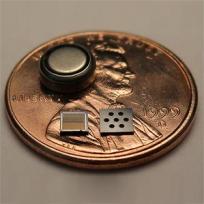3-D gesture-recognition chip could be a boon to wearable gadgets

Researchers at Berkeley Engineering and UC Davis are developing a tiny chip that uses ultrasound waves to detect a slew of gestures in three dimensions. The technology, called Chirp, could eventually be used in everything from helmet cams to smart watches.
As the MIT Technology Review reports, the technology is slated to be spun out into its own company, Chirp Microsystems, to produce the chips and sell them to hardware manufacturers. Chirp’s team believes that its technology, which requires building the electronics and an ultrasound chip into the device you want to control, allows for much more accurate gestures and lower power consumption—and can work in the dark or bright light—making it ideal for small electronics such as smart watches and head-mounted computers like Google Glass.
“There aren’t a whole lot of options of what you can do on a touch screen when it’s about the size of a quarter or so,” says Richard Przybyla, a graduate student at UC Berkeley’s Berkeley Sensor & Actuator Center, who designed the ultrasound chip.
